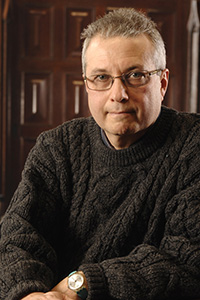2022-2023 Baylor Lecture Series in Mathematics
Carlos E. Kenig
Dr. Carlos E. Kenig, the Louis Block Distinguished Service Professor in the Department of Mathematics at the University of Chicago, will be the speaker in the 14th Baylor Lecture Series in Mathematics when he visits Baylor University on September 18-19, 2023.
Professor Kenig is a world leading expert in linear and nonlinear partial differential equations (PDE) and in
harmonic analysis. Kenig is one of the pioneers in the study of elliptic boundary value problems (BVP) in rough geometric settings, thus solidifying fundamental links between harmonic analysis, geometry, and PDE (initiating the study of holomorphic Hardy spaces in non-smooth domains, developing a geometric De Giorgi-Nash-Moser theory, employing Rellich identities and using the atomic theory of real-variable Hardy spaces in connection with elliptic BVP, taking the multifaceted theory of harmonic measure to incredible new heights, and identifying the most general geometric setting where the nontangential boundary behavior of harmonic functions is meaningful, among many other landmark achievements). Kenig has also made pioneering contributions to the study of nonlinear dispersive equations, including his groundbreaking research on the classification of the long-time behavior of large solutions, well‐posedness, scattering, and blow-up results for the generalized Korteweg‐De Vries equation and the non-linear Schrödinger equation.
Carlos E. Kenig was born in Buenos Aires, Argentina in 1953. He obtained his PhD at the University of Chicago in 1978. His influential thesis, titled Hp Spaces on Lipschitz Domains, was written under the supervision of Alberto Pedro Calderón. After graduation, he went to Princeton University as an Instructor and in 1980 he joined the University of Minnesota as an Assistant Professor. By 1983 he was promoted to Full Professor, and in 1985 he returned to the University of Chicago. Professor Kenig has supervised close to 40 Ph.D. students and mentored over 45 postdoctoral fellows.
Dr. Kenig is a Member of the National Academy of Sciences, a Fellow of the American Academy of Arts and Sciences, a Fellow of the American Mathematical Society, and a Foreign Member of the Istituto Lombardo, Accademia di Scienze e Lettere. He was awarded the Salem Prize in 1984, and the Bocher Prize of the American Mathematical Society in 2008. He was an invited speaker at the International Congress of Mathematicians in 1986 and 2002, and a plenary speaker in 2010. He was an Alfred P. Sloan Research Fellow (1981-1983), and a John Simon Guggenheim Fellow (1986). He has been awarded Doctor Honoris Causa from University of Cergy-Pontoise, France, and from University of the Basque Country, Spain. He served as the President of the International Mathematical Union 2019 – 2022.
For a poster advertising Professor Kenig's public lecture, click here.
The titles, and abstracts, for his lectures, with dates are:
PUBLIC LECTURE: “Simplification” in Partial Differential Equations
Monday, September 18, 2023, at 4:30 pm - Hankamer H101 - Kayser Auditorium
Abstract: We will recall the origins of Fourier analysis and its connection to partial differential equations through the work of Fourier on heat conduction in the early 19’th century. This led to the representation of solutions of evolutionary equations by the Fourier method, as a superposition of plane waves, a remarkable “simplification” that transformed the study of linear partial differential equations and led to fundamental technical advances in the 19th century. With the advent of computers in the middle of the 20’th century, through the remarkable computations of Fermi-‐Pasta-‐Ulam (mid50s) and Kruskal-‐Zabusky (mid 60s) it was observed numerically that nonlinear equations modeling wave propagation, asymptotically, also exhibit a “simplification”, this time as superposition of “traveling waves” and “radiation”. This has become known as the “soliton resolution conjecture”. The only proofs available have been for “integrable” equations, which can be reduced to a collection of linear equations. The proof of such results, in the non-‐integrable case, has been one of the grand challenges in the study of nonlinear differential equations. Recently, there have been important breakthroughs in obtaining mathematical proofs of these types of numerical observations, in the context of nonlinear wave equations, which I will discuss.
COLOQUIUM LECTURE: Unique Continuation and Boundary Unique Continuation, Old and New
Tuesday, September 19, 2023, at 2:30 pm - Sid Richardson Building SDRICH 344
Abstract: We will recall the notion of unique continuation of solutions of elliptic equations from the work of Hadamard and Carleman in the early 20th century, with further contributions by many of the top analysts on the 20th century. We will then discuss recent progress, in connection with problems in geometry, motivated by the study of nodal sets, singular sets and critical sets. We will then turn to corresponding problems up to the boundary and explain older and recent progress on the connection between boundary unique continuation and regularity of the boundary.
